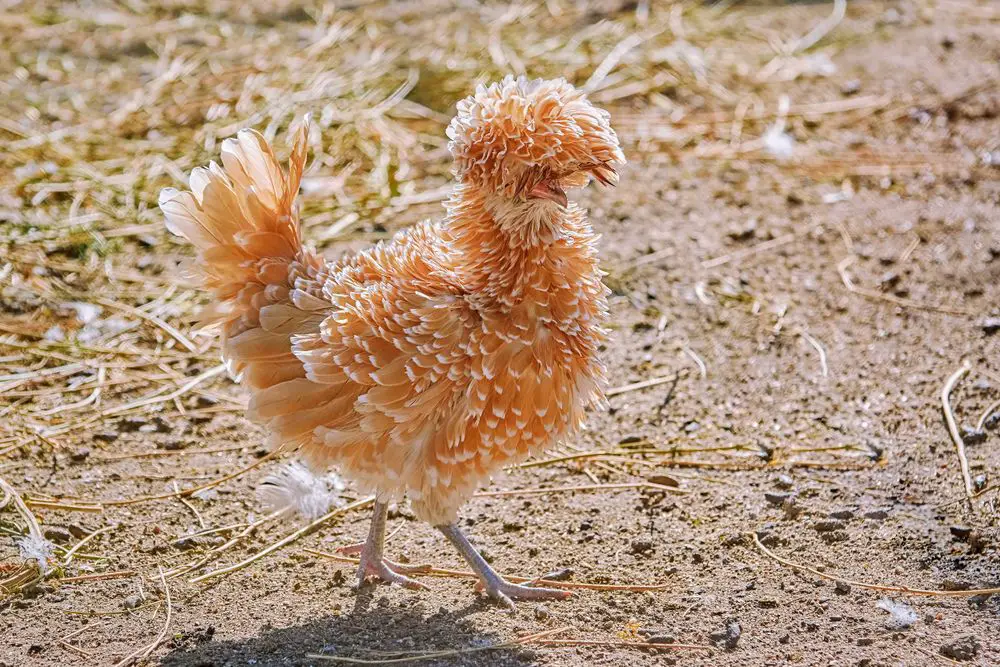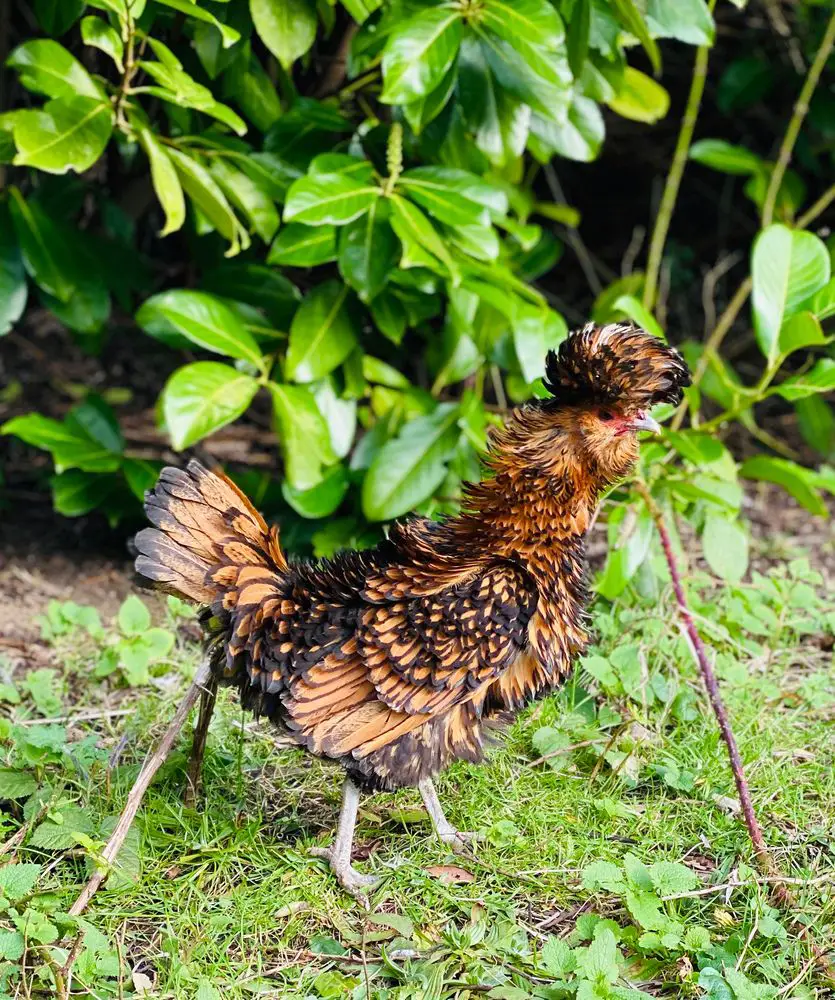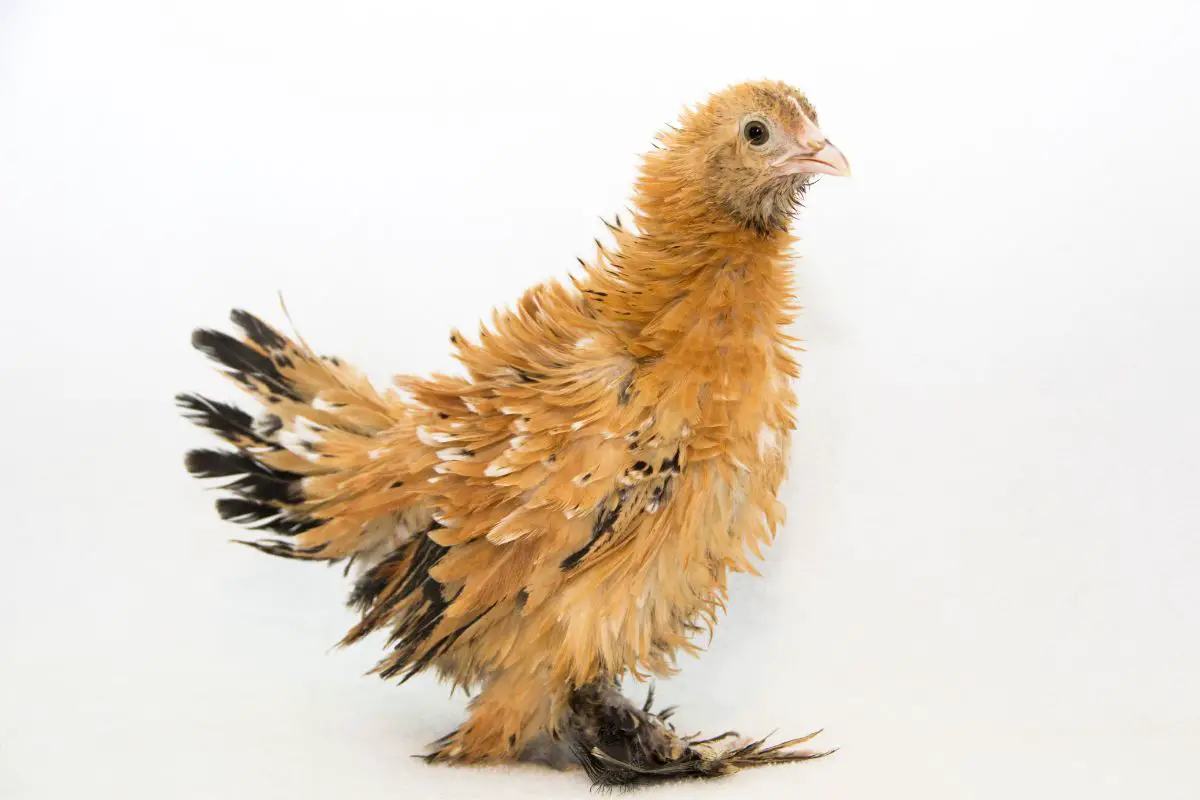Frizzle Polish chickens are a beautiful variety of Polish chicken and have unique frizzle feathers, making them a popular choice as ornamental birds. Polish chickens are a centuries-old breed originally from the Netherlands and are primarily used for egg laying.
Frizzle feathers are feathers that don’t align with the body, and instead curl dramatically and grow outward which gives a fluffy and disheveled appearance.
Polish Chickens are one of the most dramatic-looking chicken breeds with incredible crests that make them look as though they are wearing a crown of feathers. Adding in the frizzled body feathers makes for a chicken that is a showstopper!
Frizzled Polish chickens come in both standard and bantam sizes. They have long been admired by chicken fanciers since the 17th century in Europe, and are today used in poultry shows worldwide.
The American Poultry Association (APA) accepts 10 varieties of Polish breed, excluding the Tolbunt Polish, and the Standard of Perfection allows frizzled, silkie, and smooth-feathered types.
The most popular frizzled varieties of Polish chickens are the White Crested Black Polish and the Buff Laced Polish.
Table of Contents
Frizzled Polish Chicken Breed Overview
| Recognized Breed Name | Frizzled Polish Chicken |
| Lifespan | 7 to 8 years |
| Coloring and Pattern | Can come in different varieties Has red wattles and combs and white earlobes |
| Weight | 4.5 to 6lbs Bantam less than 1.8lbs |
| Comb Type | V-shaped comb |
| Distinctive Details | Crest of feathers resembles a pom-pom. Hens have sleek “bob-like” crests and roosters have tousled crests |
| Feather Type | Frizzle |
| Heritage Breed | Yes |
| Tolerant to Heat? | Yes |
| Tolerant to Cold? | No |
| Meat Production Breed? | No |
| Egg Production Breed? | Yes |
| Lays in Winter? | No |
| Egg Size | Medium |
| Egg Color | White |
| Egg Production | 200/Year |
| Starts Laying | 20 weeks |


Temperament
Frizzled Polish chickens are quirky, friendly and docile chickens, perfect for backyard flocks. They do well in confinement and in areas that are familiar to them.
Their obstructed eyesight can cause nervousness in this breed if around unfamiliar people or other animals. If you notice anxiety behavior such as feather plucking, it may be worth it to give their crest a trim to help them see their surroundings.
Frizzled Polish Chicken Coop
Frizzled Polish chickens require a spacious chicken coop with a minimum of 12 square feet per chicken. Perches and roosts should be built closer to the ground than for other breeds.
The Livestock Conservancy warns that they are vulnerable to aerial predators due to limited eyesight so it is not a good idea to let them free-range in their chicken run unobserved.
Breeders should provide nesting boxes that measure 12 x 12, with each box housing no more than 2 hens at once. Frizzled Polish hens are not broody and will likely not sit on their eggs long enough to hatch their baby chicks without assistance.
Frizzled Polish chicks will likely need assistance from an incubator to hatch. A brooder should also be available in the hatchery, with a sufficiently safe heat source, a feeder and a chick waterer.
Keeping the chicken coop clean is vital, especially in areas with baby chicks, as these chickens are especially vulnerable to parasites and chicken lice.
Frizzled Polish Feeding and Health
What you feed your Frizzled Polish chickens will greatly be determined by their age.
Baby chicks should start with a high-quality chick starter, and then move to grower feed once they reach six weeks old. They will graduate to layer feed around the 12-week mark.
Frizzled Polish hens need layer feed with a protein content between 16 and 18 percent. They also will require supplemental calcium in the form of oyster shell to help with the thickness of their eggshells and overall egg production.
Lastly, your flock will need access to chick grit at all times. This is especially important for Frizzled Polish chickens who are not free-range, and won’t pick up enough grit. It is vital for their digestion and overall health.
Frizzled Polish chickens tend to be fairly healthy birds, but feather pecking can be a problem for these beautiful chickens, particularly when they are stressed or don’t have enough space in their coop.
If your Frizzled Polish chickens seem anxious or nervous, it can be beneficial to trim the feathers that hang in front of their eyes. Trimming can also help prevent eye infections which are prominent in this breed.
They are also vulnerable to parasites as their frizzled feathers allow for a lot of openings to their skin, which is why numerous perches are required in their chicken coop.
Always inspect your flock for signs of ectoparasites and chicken lice – they particularly love to hide in the beards of bearded varieties.
Frizzled Polish chickens do not do well in harsh winter climates, because their feathers are not knitted tightly together to keep their bodies warm. Always ensure their chicken coop is climatized for their comfort and safety.
FAQs
Are Frizzled Polish Chickens Friendly?
Yes! Frizzled Polish chickens are known as a friendly breed of chicken and enjoy the company of their chicken owners. They can be a bit skittish with strangers if their eyesight is compromised.
What are the Best Features of Frizzle Polish Chickens?
Frizzled Polish chickens have a lot of wonderful features!
- Polish hens rarely go broody, so collecting your breakfast will be a breeze!
- Frizzled Polish pullets will begin to lay faster than other egg-laying breeds such as Cochins and Plymouth rocks.
- They are a guaranteed conversation starter and will be the most photographed of all your backyard chickens.
- Frizzled Polish chickens are usually front-runners for prizes at poultry shows, though other frizzled chickens like Silkie chickens may prove stiff competition!
How do Polish Frizzle Chickens Protect Themselves?
Frizzled Polish chickens can have a difficult time protecting themselves because of their large crests which interfere with their eyesight. For this reason, it is good to either keep them under direct supervision or in an enclosure that is safe from predators.
Frizzled Polish roosters in particular tend to be vigilant in trying to watch over and defend hens. Their nervous nature can be of benefit in the event of a predator slipping through defenses as they are quite vocal and will warn the flock.

